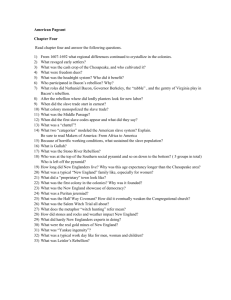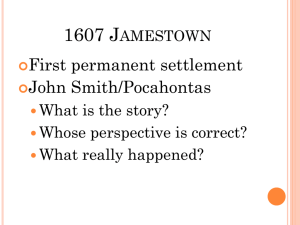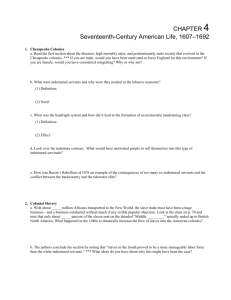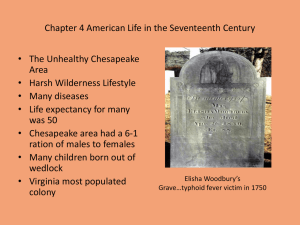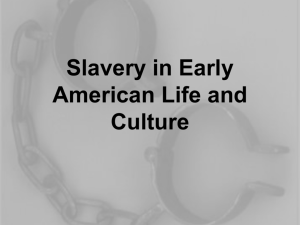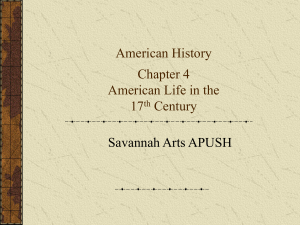Ch.4, p.66-72, Erin Hall
advertisement
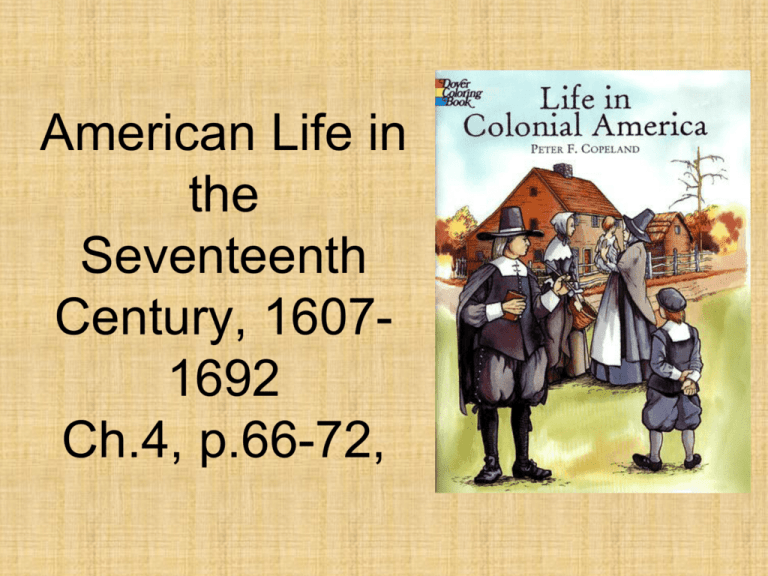
American Life in the Seventeenth Century, 16071692 Ch.4, p.66-72, The Unhealthy Chesapeake • Life in the American wilderness was harsh. • Diseases like malaria, dysentery, and typhoid killed many. • Few people lived to 40 or 50 years. • The population of the Chesapeake colonies throughout the first half of the 17th century was notable for its scarcity of women. So scarce that men fought over them. A 6:1 male to female ratio is a good guide. • Few people knew any grandparents, and due to the high death rate in the Chesapeake colonies, families were both few and fragile. • A third of all brides in one Maryland county were already pregnant before wedding (scandalous!). • Virginia, with 59,000 people, became the most populous colony. The Tobacco Economy • The Chesapeake was very good for tobacco cultivation. • Chesapeake Bay exported 1.5 million pounds of tobacco yearly in the 1630s, and by 1700, that number had risen to 40 million pounds a year. – More availability led to falling prices, and farmers still grew more. – The headright system encouraged growth of the Chesapeake. Under this system, if an aristocrat sponsored an indentured servant’s passage to America, the aristocrat earned the right to purchase 50 acres land, undoubtedly at a cheap price. This meant land was being gobbled by the rich, and running out for the poor. – Early on, most of the laborers were indentured servants. • Life for them was hard, but there was hope at the end of seven years for freedom. At least indentured servants could reasonably expect a suit of clothes, a few barrels of corn, and at times, a small parcel of land. • Conditions were brutal, and in the later years, owners unwilling to free their servants extended their contracts by years for small mistakes. Frustrated Freeman and Bacon’s Rebellion • By the late 1600s, there were lots of free, poor, landless, young single men frustrated by the lack of money, work, women, and the inability to acquire land. • In 1676, Nathaniel Bacon led a few thousand of these men in a rebellion against the hostile conditions. – These backwoods farmers wanted land and were resentful of Virginia governor William Berkeley’s friendly policies toward the Indians. – Bacon’s men murderously attacked Indian settlements after Berkeley refused to retaliate for a series of savage Indian attacks on the frontier. • Then, in the middle of his rebellion, Bacon suddenly died of disease, and Berkeley went on to crush the uprising. • Still, Bacon’s legacy lived on, giving frustrated poor folks ideas to rebel, and so a bit of paranoia amongst the wealthy went on for some time afterwards. Colonial Slavery • For those Africans sold into slavery, the “middle passage” can best be described as the gruesome ocean voyage to America. • In the 300 years following Columbus’ discovery of America, only about 400,000 of a total of 10 million African slaves were brought over to the United States. • By 1680, though, many landowners were afraid of possibly mutinous white servants (ie. Bacon’s Rebellion) and began to turn to less troublesome laborers. In addition to this fear, African slave labor in colonial America also rapidly increased because: – Higher wages in England reduced the number of emigrating indentured servants. – The British Royal African company lost its monopoly on the slave trade in colonial America, so…….. – Americans subsequently rushed to cash in on the slave trade. • • As a result, by the mid 1680s, for the first time, black slaves outnumbered white servants among the plantation colonies’ new arrivals. • After 1700, more and more slaves were imported, and in 1750, blacks accounted for nearly half of the Virginian population. – Most of the slaves were from West Africa, from places like Senegal and Angola. • Some of the earliest black slaves gained their freedom and some became slaveholders themselves. • Eventually, to clear up issues on slave ownership, the slave codes made it so that slaves and their children would remain slaves to their masters for life (chattels), unless they were voluntarily freed. – Some laws made teaching slaves to read a crime, and not even conversion to Christianity might qualify a slave for freedom. Page 72-78 •Africans in America •Southern Society •The New England Family Africans in America • Slave life in the Deep South was very tough, as rice growing was much harder than tobacco growing. – Many blacks in America evolved their own languages, blending their native tongues with English. – Blacks also contributed to music with instruments like the banjo and bongo drum, all of which directly contributed to the evolution of jazz as perhaps the first truly original American music. • A few of the slaves became skilled artisans (i.e. carpenters, bricklayers and tanners), but most were relegated to sweaty work like clearing swamps and grubbing out trees. • • Revolts did occur. – In 1712, a slave revolt in New York City cost the lives of a dozen whites and 21 Blacks were executed. – In 1739, South Carolina blacks along the Stono River revolted and tried to march to Spanish Florida, but failed. • Just before the Revolutionary War, 70% of the leaders of the Virginia legislature came from families established in Virginia before 1690. • • Social ScaleGreat Planters-owned gangs of slaves and vast domains of land; ruled the region's economy and monopolized political power. • Landowning Small Farmers-largest social group of the colonial American South; tilled their own modest plots and may have owned one or two slaves. • Landless Whites-many were former indentured servants. • Black Slaves • Urban development in the colonial South was slow to emerge. Southern Society The New England Family • In contrast with the Chesapeake, the New Englanders tended to migrate in families as opposed to single individuals, thus the New England family was very stable institution. • There were low premarital pregnancy rates, in contrast with the Chesapeake • Because southern men frequently died young, leaving widows with small children to support, the southern colonies generally allowed married women to retain separate title to their property and gave widows the right to inherit their husband's estates. • But in New England, Puritan lawmakers worried that recognizing women's separate property rights would undercut the unity of married persons by acknowledging conflicting interests between husband and wife. When a man died, the Church inherited the property, not the wife. • New England women usually gave up their property rights when they married. In contrast to old England, the laws of New England made secure provisions for the property of widows and even extended important protections to women with marriage. • Above all, the laws of Puritan New England sought to defend the integrity of marriages. Page 78-82 •Life in New England Towns •The Half-Way Covenant and Salem Witch Trials •The New England Way of Life •Early Settlers Days and Ways Life in the New England Towns • • • • • • • • New towns were legally chartered by the colonial authorities in the following fashion: - a land grant was given by the legislature. - a meeting house was built (often the church or town hall, sometimes the same place) - Every family received several parcels of land. Towns of more than 50 families had to have an elementary school. Just 8 years after Massachusetts was formed, the colony established Harvard College, in 1636. Virginia established its first college, William and Mary, in 1693. Puritans ran their own churches, and democracy in Congregational Church government led logically to democracy in political government. Massachusetts was at the front of the colonies attempting to abolish black slavery The Half-Way Covenant and the Salem Witch Trials • About the middle of the 17th century, a new form of sermon began to be heard from Puritan pulpits - the “Jeremiad.” • Troubled ministers in 1662 announced a new formula for church membership, the Half-Way Covenant. This new arrangement modified the covenant, or the agreement between the church and its adherents, to admit to baptism-but not "full communion"-the unconverted children of existing members. This move upped the churches' memberships. This boost in membership was just what the moneystricken church needed. • A group of adolescent girls in Salem, Massachusetts, claimed to have been bewitched by certain older, property-owning women, a threat to male-dominated Puritan New England. A witch hunt ensued, leading to the legal lynching of 20 women in 1692. • In 1693, the witchcraft hysteria ended when the governor of Massachusetts prohibited any further trials and pardoned those already convicted. In 1713, the Massachusetts legislature annulled the "conviction" of the "witches" and made reparation to their heirs. The New England Way of Life • The soil of New England was stony and hard to plant with. • There was less diversity in New England than in the South because European immigrants did not want to come to a place where there was bad soil. The summers in New England were very hot and the winters very cold. • The Native Americans recognized their right to USE the land, but the concept of OWNING was unknown. ECONOMY • The New England economy depended heavily on fishing, shipbuilding, and commerce. • They became experts at shipbuilding and commerce due to the timber found in the dense forests. They also fished for cod off the coasts. • The combination of Calvinism, soil, and climate in New England made for energy, purposefulness, sternness, stubbornness, self-reliance, and resourcefulness. The Early Settlers’ Days and Ways • Women, slave or free, on southern plantations or northern farms, wove, cooked, cleaned, and care for children. Men cleared land; fenced, planted, and cropped the land; cut firewood; and butchered livestock as needed. • Resentment against upper-class pretensions helped to spark outbursts like Bacon's Rebellion of 1676 in Virginia and the uprising of Maryland's Protestants toward the end of the 17th century. • New York, animosity between lordly landholders and aspiring merchants fueled Leisler's Rebellion, an ill-starred and bloody insurgence that rocked New York City from 1689-1691. • In 1651, Massachusetts prohibited poorer folk from "wearing gold or silver lace," and in 18th century Virginia, a tailor was fined and jailed for arranging to race his horse-"a sport only for gentlemen." • The English justified taking land from the native inhabitants on the grounds that the Indians: - wasted the earth. All in all, compared with most 17th century Europeans, Americans lived in affluent abundance. Chronology • 1619 • 1636 • 1662 • 1670 • • • • • • 1676 1680s 1689-1691 1692 1693 1698 • 1712 • 1739 - First Africans arrive in Virginia - Harvard College founded - Half-Way Covenant for Congregational Church membership established - Virginia assembly disfranchises landless freeman - Bacon's Rebellion in Virginia - Mass expansion of slavery in colonies - Leisler's Rebellion in New York - Salem witch trials in Massachusetts - College of William and Mary founded - Royal African Company slave trade monopoly ended - New York City slave revolt - South Carolina slave revolt
